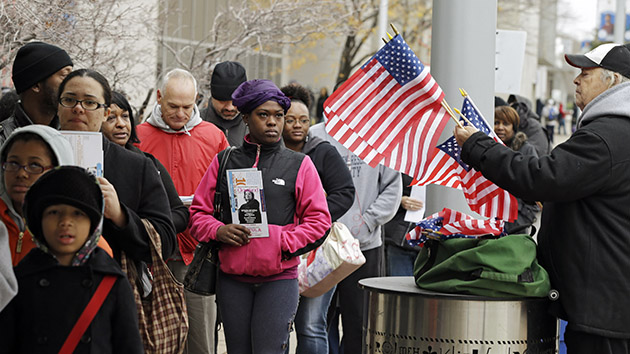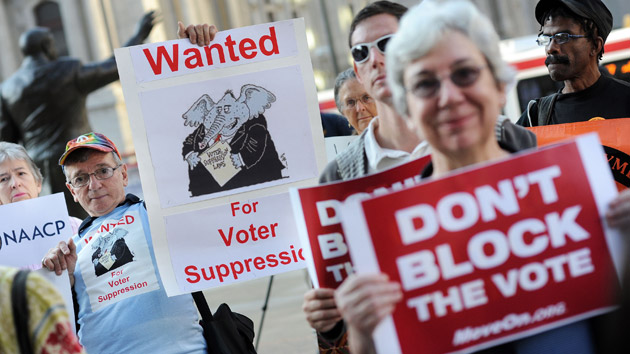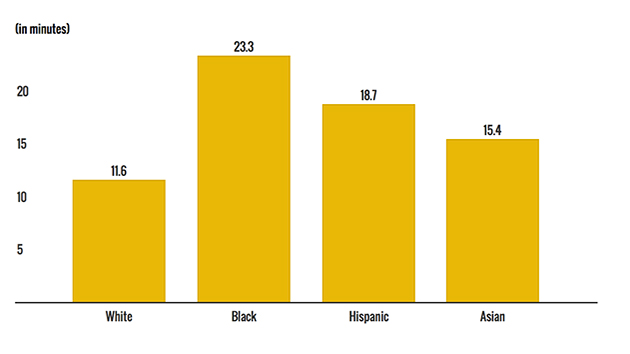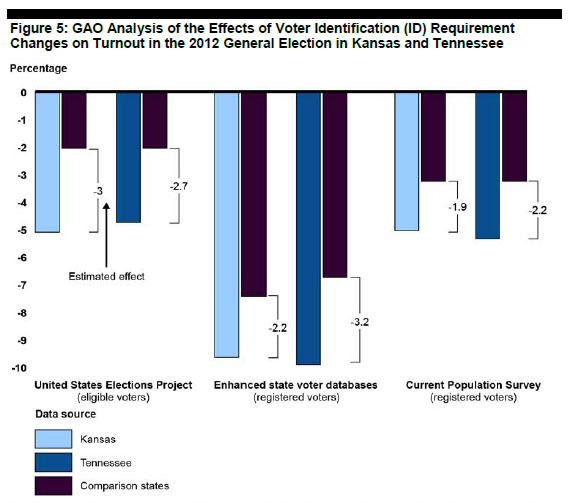
Voters in Cleveland, Ohio, wait in line to cast early votes in November 2012.Mark Duncan/AP
Over the past decade, Republican legislators have pushed a number of measures critics say are blatant attempts to suppress minority voting, including voter ID requirements, shortened early voting periods, and limits on same-day voter registration. But minority voters are often disenfranchised in another, more subtle way: polling places without enough voting machines or poll workers.
These polling places tend to have long lines to vote. Long lines force people to eventually give up and go home, depressing voter turnout. And that happens regularly all across the country in precincts with lots of minority voters, even without voter ID or other voting restrictions in place.
Nationally, African Americans waited about twice as long to vote in the 2012 election as white people (23 minutes on average versus 12 minutes); Hispanics waited 19 minutes. White people who live in neighborhoods whose residents are less than 5 percent minority had the shortest of all wait times, just 7 minutes. These averages obscure some of the unusually long lines in some areas. In South Carolina’s Richland County, which is 48 percent black and is home to 14 percent of the state’s African American registered voters, some people waited more than five hours to cast their ballots.
A recent study from the Brennan Center for Justice suggests that a big factor behind these delays was inadequately prepared polling places in heavily minority precincts. Looking at Florida, Maryland, and South Carolina, three states that had some of the longest voting lines in 2012 , the center found a strong correlation between areas with large minority populations and a lack of voting machines and poll workers. In South Carolina, the 10 precincts with the longest waits had more than twice the percentage of black voters (64 percent) as the state as a whole (27 percent).
In the parts of South Carolina with the longest lines (all in Richland County), precincts had an average of only 1 poll worker for every 321 voters, almost twice the state’s mandated ratio of 1 to 167. These precincts also had the fewest voting machines relative to registered voters, with some precincts hitting 432 voters per machine. In contrast, precincts with no wait times had an average of 279 voters per machine. State law requires no more than 250 voters per machine, a limit implemented under the Voting Rights Act. Research shows that voter participation starts to drop off sharply when the number of registered voters per machine exceeds that.
Voting difficulties are not only a problem in poor areas; even well-off African Americans have had a hard time voting. Consider, for instance, Prince George’s County, Maryland, the wealthiest African American suburb in the country, which has the highest proportion of minority residents of any county in the state. In 2012, P.G. County saw three-hour waits to vote. It had the state’s highest number of precincts without the legally required number of voting machines. In most of its precincts, the county had only one voting machine for every 230 registered voters; state law requires no more than 200 voters per machine.
The racially imbalanced distribution of voting resources has spurred allegations that state and local officials are violating the Voting Rights Act, which bars implementing election policies that deny people the right to vote based on race. In 2004, the House Judiciary Committee held field hearings to examine irregularities in voting in Ohio, including long lines in minority areas of the hotly contested swing state in that year’s presidential election. Franklin County, which includes Columbus and had twice the proportion of black voters as the rest of the state, was ground zero for long voting lines. Anecdotal evidence suggested that 5,000 to 10,000 people in Columbus walked away from the polls because of long lines. One woman reported that during the four hours she had to wait to vote in Franklin County, her husband died at home alone.
After the 2004 election, University of Michigan political scientist Walter Mebane studied Franklin County for the Democratic National Committee, which wanted to figure out why so many likely Democratic voters had been unable to vote. He found that precincts with large minority populations had nearly 24 percent more registered voters per voting machine than in precincts whose population was less than one-quarter minority. Mebane estimated that the voting machine shortage had reduced potential voter turnout in those areas of Franklin by about 4 percent. Another estimate suggested that roughly 130,000 would-be voters were turned away thanks to long lines. (Those missing votes would not have been enough to swing the state for John Kerry, but they were enough to fuel conspiracy theories for years afterward.)
The Advancement Project, a civil rights organization, sued Virginia shortly before the 2008 presidential election, alleging that African American voters were getting short-changed on voting machines. Mebane’s analysis of election officials’ plans revealed that in Richmond and Virginia Beach, the larger the percentage of African American voters in a precinct, the fewer voting machines would be provided. In Richmond, for instance, in areas where fewer than 12 percent of the residents were black, officials planned to provide a voting machine for every 232 registered voters. In areas where residents were virtually all black, there would only be one machine for every 308 registered voters. Nonetheless, a state court threw the case out.
The reasons for the lack of voting machines and long wait times in minority communities isn’t always clear. At the county level, it is hard to find evidence of Republican schemes to keep heavily Democratic areas from voting. Local officials are responsible for buying voting machines and staffing polling places. Many of the places with the fewest resources and longest lines are governed by African Americans and Latinos and tend to skew Democratic. Take Maryland’s P.G. County. Alisha Alexander, the county’s election administrator, told me that voter registrations for the 2012 election far surpassed projections made in the early 2000s, yet the county still had the same number of voting machines. Those machines, purchased in 2001, were nearing the end of their useful lives and could not be easily fixed or replaced since they were no longer being manufactured. “You can’t mix and match voting equipment,” Alexander explains. State law required the county to use the same type of machine everywhere. “We literally had all of our voting units out in the field between early voting and Election Day, but there was no mechanism to get additional units.”
The 2012 election in Richland County, South Carolina, was a disaster that officials are still trying to untangle. Nearly 100 voting machines sat in a warehouse, unused on election night while voters queued up for as long as seven hours to vote at overburdened polling places. (Local conspiracy theorists have suggested—incorrectly—that the election office stiffed precincts on voting machines in areas that opposed a controversial tax proposal that voters rejected in 2010.)
Charles Stewart III, a political science professor at the Massachusetts Institute of Technology who has studied voting wait times, has posited that the problem is likely related to the poor provision of public service in minority areas in general. In other words, if you don’t have good trash pick up, your polling station isn’t likely to function very well, either.
Regardless of the cause, it is indisputable that African Americans and Latinos often have a much harder time voting than white people. This history inspired many of the election reforms that Republicans are now actively trying to roll back in places like Ohio and North Carolina, which the Supreme Court has essentially approved.
After the disastrous election in Ohio in 2004, state lawmakers and election officials created opportunities for early and absentee voting, and allowed people to register to vote and cast a ballot on the same day. The state required that every polling station have at least one voting machine for every 175 people. By 2012, roughly a third of all voters cast ballots early and the lines didn’t make the evening news.
But since Barack Obama was elected, the GOP-dominated Ohio state Legislature has been working feverishly to roll back those measures, which many Republicans view as too favorable to Democrats. In 2012, Doug Preisse, the chairman of the Franklin County Republican Party explained to the Columbus Dispatch, “I guess I really actually feel we shouldn’t contort the voting process to accommodate the urban—read African American—voter turnout machine.”
In 2011, the Legislature passed a bill killing off what’s known as “Golden Week,” where people could register and vote on the same day during the first of four weeks of early voting. Following a ballot initiative to overturn the measure, the legislature repealed the law. Earlier this year, Republican lawmakers once again eliminated Golden Week, and the Republican secretary of state, Jon Husted, issued a rule eliminating early voting on Sundays, the Monday before the election, and all evenings after five o’clock. The American Civil Liberties Union sued the state, at first blocking the measure in federal court. But in late September, the Supreme Court allowed the state to proceed.
Early voting and other reforms to make voting easier for everyone were not designed to boost Democrats but simply to even the playing field. That’s why the new measures in places such as Ohio and North Carolina that pare back early voting and pile on new ID and registration requirements are likely to create a double whammy for minority voters by compounding existing problems at the polls. Strict new ID requirements in particular are likely to lead to longer lines as voters try to figure out the new system at precincts that may already be suffering from a shortage of poll workers.
Carrie Davis, the executive director of the Ohio League of Women Voters, says it’s not yet clear how this year’s Election Day will turn out. The state has consolidated polling places due to the success of early and absentee voting in reducing the high demand on Election Day. In 2010, for instance, Franklin County went from 123 precincts to 61. Such moves raise concerns about a return of long lines, particularly in minority precincts. “With the law change and court action, this will be the first time we don’t have evening early and in-person voting, so that will impact people. All of these different restrictions, whether they’re subtle or obvious, they add up. And that’s the concern. Does that put voters off?” Davis wonders.
Probably so. Consider what happened in 2012 in Lee County, a Florida county named after the Confederate general that was subject to a federal school desegregation order until 1999. The number of registered voters in the county jumped 70,000, from about 320,000 in 2008 to 390,000 in 2012. During the same time, the state provided 14 days of early voting before elections; more than 30,000 of Lee County voters voted early during that period in 2010. Those early voters allowed the county to pare back the resources it needed to deploy on Election Day without causing much disruption to the election. According to the Orlando Sentinel, during that same time the county consolidated its polling stations, shrinking their numbers from 136 to 88.
But in 2011, the state Legislature passed a law reducing the early voting period from 14 to 8 days. The next year, Lee County had some of the state’s longest voting lines on Election Day, with some voters waiting as long as five hours. Many others likely gave up without voting. (One study estimated that long lines deterred more than 200,000 people from voting in Florida in 2012.)
Not all Lee County voters were equally inconvenienced. Lee County is about 87 percent white, 19 percent Hispanic, and 9 percent black. Precincts with more than 20 percent Latino voters had on average about 2,000 voters per machine, compared with about 1,500 in areas that were 10 percent or less Latino. In areas of the county where African Americans and Latinos made up 40 to 50 percent of the population, precincts on average had a machine for every 2,150 voters, compared with 1,485 in areas with less than 10 percent minority populations.
Myrna Perez, deputy director of the democracy program at the Brennan Center and a coauthor of its voting study, says that the center hasn’t found find any evidence that these sorts of problems were created intentionally. But because their effect is so dramatic, she says something will have to change: “We think that now election officials have been put on notice they have an obligation to address it.” Given the trends in most of these contested states, that’s not likely to happen any time soon, and especially not before tomorrow’s election, when it could make a difference.
















